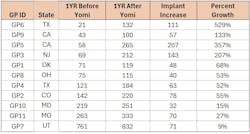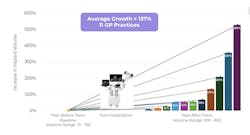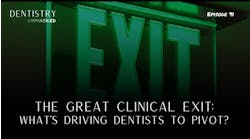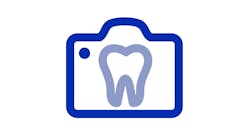Adopt the Yomi robotic system to increase implant volume and profitability for your practice
According to the American Academy of Implant Dentistry (AAID), 150 million people in the US have lost at least one permanent tooth, with a forecast of 2.7 million implant procedures and 4.5 million implant unit sales in 2024.1,2
The widespread appeal of implants lies in their ability to restore natural tooth functionality, boost confidence, and enhance the smile of the wearer. Implants can be installed freehand, using 3D printed guides, computer assistance, and—most recently—robotic guidance.
Wait ... robots can install implants?
The first FDA-cleared and commercially available haptic robotic-guided system for dental implant surgery is the Yomi system by Neocis. This easy-to-use robot is both drill and implant agnostic, allowing the type, size, and shape of the implant to be optimized for each patient. The system software utilizes haptic boundaries created from the 3D plan to provide physical guidance of the surgical tools during drilling/bone preparation and implant placement.
The 3D boundaries guide the tools in terms of location, angulation, and depth. While implants can be placed by specialists and general dentists, technology like haptic robotics—which is based on accuracy and safety—has made placing dental implants safe and simple for everyone.
Benefits of robotic implants
Utilizing this technology adds significant value to the patient by providing improved implant placement accuracy, surgical visualization, and implant flexibility.3-6 In addition to the ergonomic and efficiency benefits for the user, the adopting robotic technology for dental implant placement can have a positive economic effect on the user's practice. Dental implants are considered one of the most profitable cosmetic dentistry procedures, with a single implant procedure grossing between $3,000 to $6,000.7,8
Additionally, using robotic technology can increase implant procedural growth and patient throughput (even beyond implant cases) by cultivating a modern, digital practice. The following study was designed to evaluate the implant volume increase for a variety of general dentists from different locations and starting volumes after adopting the Yomi haptic robotic system.
Conducting a study on robotic technology
Methods used
Implant volume data was collected from 11 general dentists from Missouri, Maryland, Utah, Texas, Colorado, Ohio, California, Oklahoma, and New Jersey. Data was grouped into two sections: the practice one year before and one year after adopting the Yomi system. Data shown is for total implant numbers, which includes patients receiving everything from single implants to full arches.
Study results
The median starting annual implant volume (before adoption of the Yomi system) was 75 implants (range 21 to 761). Following adoption of Yomi, the median annual implant volume rose to 212 implants (range 100 to 832). All 11 dentists increased their implant volume with the median increase of 70 implants (table 1).
As there is such a wide variety of baseline volumes, the percentage growth for each dentist was calculated and is shown in Figure 1. Relative to the baseline year, the average volume growth a year after integrating Yomi was 137% with a minimum of 9% and a maximum of 529%.
Final thoughts
Adopting Yomi robotic implant placement significantly increased the annual implant volume of every general dentist involved in the study, with the maximum growth of 529%. This data is in line with a previously published annual volume increase of 294% following the integration of Yomi.9 That study, however, was conducted by an oral surgeon.
In sum, adapting haptic robotic technology makes implant placements routine, simple, efficient, safe, and accurate for all oral care providers. Yomi has shown the ability to democratize implant surgery, offering expert implant placement to more patients. Not only that, but the financial benefit to a dentist's practice is also substantial as dental implants represent one of the most profitable dental procedures.
References
- Dutta S. Dental Implants - Market Analysis - North America. MedTech 360. October 2018.
- U.S. market report for dental implants. iData Research.January 2019. https://idataresearch.com/product-category/dental/dental-implants/
- Rawal S, Tillery DE, Brewer P. Robotic-assisted prosthetically driven planning and immediate placement of a dental implant. Compend Contin Educ Dent. 2020;41(1):26-30.
- Bolding SL, Reebye UN. Accuracy of haptic robotic guidance of dental implant surgery for completely edentulous arches. J Prosthet Dent. 2022;128(4):639-647.
- Mozer PS. Accuracy and deviation analysis of static and robotic guided implant surgery: A case study. Int J Oral Maxillofac Implants. 2020;35(5): e86-e90.
- Neugarten JM. Accuracy and precision of haptic robotic-guided implant surgery in a large consecutive series. Int J Oral Maxillofac Implants. 2024;39(1):99-106.
- 6 most profitable dental procedures to increase revenue. Medarchive Magazine. May 24, 2023. https://medarchivemagazine.com/most-profitable-dental-procedures/
- Nugid A. Uncovering the secret to dental practice success: The most profitable dental procedures. Nadapayments. https://www.nadapayments.com/blog/uncovering-the-secret-to-dental-practice-success-the-most-profitable-dental-procedures
- Pinker B. How robotics quadrupled my practice’s implant volume. Dental Economics. November 22, 2021. https://www.dentaleconomics.com/science-tech/article/14211713/how-robotics-quadrupled-the-implant-volume-at-my-dental-practice









